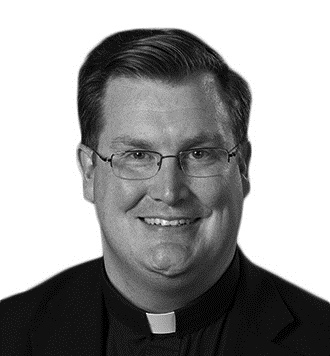On Tuesday, March 26, we celebrate the 16th anniversary of the rededication of the Cathedral of the Most Blessed Sacrament. Blessed Sacrament is the “mother church” of the Archdiocese of Detroit and the place where many of us will gather for the Chrism Mass in just a few weeks.
Adam Cardinal Maida rededicated the cathedral on March 25, 2003, almost 100 years after the parish’s founding. This feast day is an occasion for us to pray for this archdiocese and for Archbishop Allen H. Vigneron, for Cardinal Maida, and by extension for all our clergy, religious, and lay faithful.
The very name of our cathedral — the Cathedral of the Most Blessed Sacrament — gives a resounding “yes” to the question posed by King Solomon in 2 Chronicles 6:18, “Can it indeed be that God dwells on earth?” And our cathedral, like the all of the diocesan cathedrals of the world, stands as a symbol of both the local church and of our communion with the entire Catholic Church.
One of my little hobbies as I drive around the city of Detroit is to read the signs some of our Protestant brethren place in front of their churches, and to marvel at the creativity of the names, such as:
- Abundant Faith Cathedral
- Prayer Temple of Love Cathedral
- Salt Mine Church
- Ark of Deliverance Revival Center
- I AM My Brother’s Keeper Ministry
- Refreshing Word Ministry
- Triumph Church
- Church of Universal Triumph, Dominion of God (#1 Thankful Center)
- …and countless others!
Once, I proposed (in jest, of course) a new name for our cathedral to Archbishop Vigneron, pleading that the new evangelization, according to Pope St. John Paul II, is new in “methods, ardor, and expression” (emphasis added). I don’t remember the exact name I proposed, but this is a very close approximation:
The Triple-Rock, Ship of Zion, Citadel of Faith, Anointed and Appointed Ministries, Apostolic Deliverance Prayer Temple of Love Cathedral of the Most Blessed Sacrament

It seemed only right to work in the traditional name of the cathedral at the end. I presume the archbishop is still working to raise funds for a larger sign to place on Woodward Avenue.
The point — if there was a bona fide point — was that each of the names of these small city churches expresses some particular aspect or dimension of the Christian faith, something that community does well or in which it has a special interest. In the Catholic Church, however, it is our blessing to possess all of the saving gifts God has given to His people.
In other words, a cathedral church is a symbol of the Church’s catholicity, or universality, not only across space and time, but also in the fullness of the Church’s faith and life. We say this not to our own credit, but to the glory of God, Who has been so good to us, and Who by speaking and acting through us wishes to be equally good to those who do not yet share our faith.
One of these saving gifts is the apostolic ministry exercised by our bishops. A cathedral is the place where the bishop most clearly serves as chief shepherd of a diocese. It is the place of his cathedra, or seat of authority, a place where all seven of the sacraments are celebrated, and a place every Catholic can and should think of as home.
St. Ignatius of Antioch, in his Letter to the Magnesians, offers a very early teaching about the communion shared by the bishop and his priests and deacons: “I exhort you to strive to do all things in harmony with God: the bishop is to preside in the place of God, while the presbyters are to function as the council of the Apostles, and the deacons, who are most dear to me, are entrusted with the ministry of Jesus Christ” (6:1).
The Fathers of the Second Vatican Council emphasized this point about the communion of priests, and all Catholics, with their bishop. In Lumen Gentium, 28 we read:
Priests, prudent cooperators with the Episcopal order, its aid and instrument, called to serve the people of God, constitute one priesthood with their bishop although bound by a diversity of duties…On account of this sharing in their priesthood and mission, let priests sincerely look upon the bishop as their father and reverently obey him. And let the bishop regard his priests as his co-workers and as sons and friends, just as Christ called His disciples now not servants but friends.

No parish, and no priest, exists in isolation. We are all bound together in the local church of Detroit, bound to our bishop and to each other. Christ built His Church on the rock of Peter, and it is only in communion with the successors to the apostles that we can authentically live the life to which Christ calls us and which He gives us as a gift. Of this truth, our cathedral stands as a powerful symbol.
Fr. Charles Fox is a priest of the Archdiocese of Detroit currently assigned to the theology faculty of Sacred Heart Major Seminary. He is also a weekend associate pastor at St. Therese of Lisieux Parish in Shelby Township and chaplain and a board member of St. Paul Evangelization Institute, headquartered in Warren.










